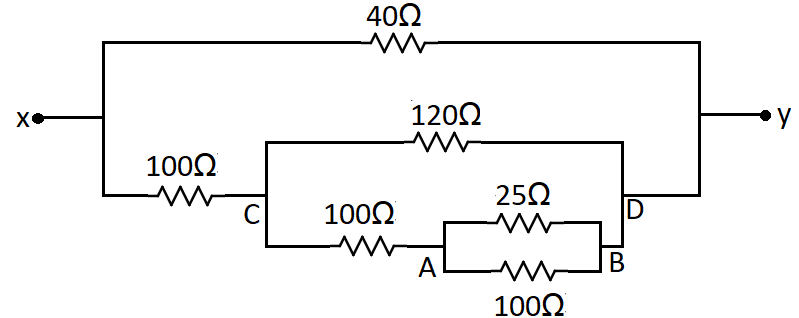Question
Question: Equivalent resistance between point x and y in the combination of resistance shown is 
(A) 20Ω
(B) 18Ω
(C) 32Ω
(D) 40Ω
Solution
Hint
To solve this we need to first draw the circuit in a simplified way. Then we need to find the equivalent of the small parallel connection between 100Ω and 25Ω. Then the equivalent in series with 100Ω and the parallel 120Ω. Finally by finding the equivalent for the series connection with 100Ω and parallel with 40Ω we get the result.
In this solution, we will be using the following formula,
⇒Req=R1+R2+R3+.... where Req is the equivalent resistance when the resistances are placed in series.
and Req1=R11+R21+R31+.... where Req is the equivalent resistance when the resistances are placed in a parallel circuit.
Complete step by step answer
To find the equivalent resistance, we first need to draw the simplified circuit. So we can draw the circuit as follows.

So first we need to find the equivalent resistance between A and B. Then using that value we need to find the equivalent resistance between points C and D. And then we can finally calculate the resistance between x and y.
So between points we have 2 resistances in parallel. So we use the formula,
⇒Req1=R11+R21+R31+....
Where we substitute, R1=100Ω and R2=25Ω. Hence we get,
⇒Req11=1001+251
We take the LCM as 100. So we get
⇒Req11=1001+4
On taking the reciprocal we get,
⇒Req1=5100=20Ω
So this resistance is in series with 100Ω in the bottom wire between the points C and D.
So we get the equivalent resistance in the bottom wire of CD as,
⇒Req2=R1+R2
We substitute, R1=100Ω and R2=Req1=20Ω
So we get,
⇒Req2=(100+20)Ω
On doing the addition we get the equivalent resistance as,
⇒Req2=120Ω
Therefore in between the points C and D there are 2 resistances in parallel. So to find the equivalent resistance between C and D we find the equivalent of the 2 resistances by,
⇒Req31=R11+R21 where we substitute R1=120Ω and R2=120Ω
So we get, Req31=1201+1201
By taking the LCM as 120, we get,
⇒Req31=1201+1
We take the reciprocal and get the equivalent resistance as,
⇒Req31=1201+1Req3=2120=60Ω
Now this resistance is in series in the bottom wire between x and y. So we get the equivalent as,
⇒Req4=R1+R2 where R1=100Ω and R2=60Ω
So we get, Req4=100+60=160Ω
This is the resistance in the bottom wire and in the top wire the resistance is 40Ω. So to get the equivalent resistance between x and y we calculate the equivalent resistance of these 2 parallel resistances as,
⇒R1=R11+R21 where R1=160Ω and R2=40Ω
So we get,
⇒R1=1601+401
On taking LCM as 160 we get,
⇒R1=1601+4
So to get R we take the reciprocal on both sides as,
⇒R=5160=32Ω
Therefore, the equivalent resistance between points x and y is 32Ω.
Hence the correct answer is option (C).
Note
The equivalent resistance of any circuit is the aggregate of all the resistances connected in series or parallel between 2 points in a circuit. For resistances in series the current flow in them are equal but in case of parallel resistances, the current flow is different and depends on the value of the resistance.
